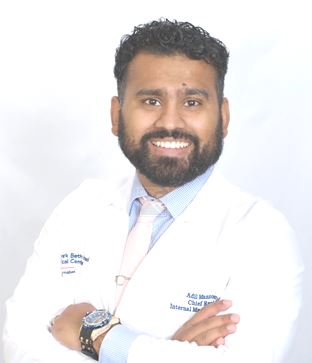THE DOCTOR IS IN

OP / ED BY DR. ADIL MANZOOR
Have you ever had a paper cut? It’s annoying as hell, pretty painful, you may bleed a little, and did I mention that it’s annoying as hell. However, have you ever had a paper cut and started to panic that your life may be at risk? The answer is almost certainly no. I mean, it’s just a paper cut. What if something goes wrong, and it gets infected? Well, you just use antibiotics, and voila, you’re fine.
But did you know that there used to be a time when even the smallest injuries raised serious health concerns because there was no cure if they got infected? This was the time before antibiotics. Urinary tract infections, respiratory infections, sexually transmitted infections, and post-operation wounds all represented very serious health risks. In fact, 30% of deaths in the United States used to be due to bacterial infections. This is why the invention of the first antibiotic (penicillin) in 1928 by Alexander Fleming is one of the most important inventions in all of human history.
Fleming went on to win the Nobel Prize in 1945 for his groundbreaking invention, and during his acceptance speech, he raised a concern – that incorrect usage of penicillin could cause resistance. Antibiotic resistance is simply when bacteria become more resistant to antibiotics, and these antibiotics are no longer nearly as effective in killing or stalling their growth. Bacteria are living organisms, and like all living organisms, they can adapt to changes and evolve into genetically superior versions of themselves.
Causes and contributors to antibiotic resistance include poor hospital hygiene practices, antibiotic overuse in humans and agriculture, lack of sanitation, international travel spreading resistant bacteria, and the lack of quick diagnostics that help in proper antibiotic use. Practically, you can contribute to antibiotic resistance by using antibiotics for viral infections (like the common cold), not completing the course of your antibiotics, and using antibiotics without a prescription.
Before long, Fleming’s concerns about resistance evolved from mere concerns into reality, as the first case of penicillin resistance was observed in 1947. In 1959, scientists developed an antibiotic, known as methicillin, to treat infections caused by penicillin-resistant bacteria (Staphylococcus aureus, in particular). Barely two years after methicillin was developed, methicillin-resistant Staphylococcus aureus was discovered. This should give you an idea of how aggressive bacteria are in their efforts to gain resistance against antibiotics.
Right from the first use of antibiotics in the 1940s, there have been concerns about antibiotic resistance. Fast forward eight decades later, and these concerns have reached an all-time high. According to the World Health Organization, the world “is running out of antibiotics.” The WHO also named antimicrobial resistance as one of the top 10 global public health threats to humanity. As dire as that projection sounds, it still feels very much like antibiotic resistance is understated and overlooked, especially by pharmaceutical companies.
In case you were wondering, antibiotic resistance is so bad because it can make healthcare extremely difficult. Antibiotic resistance is responsible for around 5 million deaths worldwide, but that figure is expected to double by 2050 (which is around 25 years away). And it’s only going to get worse from thereon in.
Currently, 7 in 10 pathogenic bacteria are believed to be resistant to at least one commercially available antibiotic. Again, if current trends are anything to go by, this will only worsen, and while we all; hope not, there may be a time when more than 90% of pathogenic bacteria will be resistant to available antibiotics. Just saying it is scary, but you need to fully understand the implications of this.
If a lot of bacteria become resistant to available antibiotics, many people will die. Then, it will become more difficult to treat many health conditions, significantly affecting the quality of life of millions. There could even be the development of new health conditions that just don’t respond to existing treatments, and that will wreak even more havoc, just think of the early COVID-19 days. Speaking of which, studies show that COVID-19 actually made antibiotic resistance worse due to the overuse of antibiotics in humans, continued misuse in plants and animals, and an even reduced focus on antibiotic production by pharmaceutical companies.
What’s more, surgeries will become difficult, as post-operation infections will soar. So, people who need organ transplants, caesarean sections, heart surgeries, brain surgeries, chemotherapy, and more will see a sharp drop in their risk of survival and good health after their surgeries. There is also the fact that treatments will become far more expensive as antibiotic resistance progresses.
With all of these said, it is pretty clear that we need to drastically slow down the rate of antibiotic resistance. Several scientific methods have been considered, ranging from the use of immuno-antibiotics, modifying bacterial DNA repair processes, and disrupting hydrogen sulfide biosynthesis pathways. More research is needed in these areas. However, we must play our part in responsibly using antibiotics, following strictly the instructions of healthcare providers. There could also be more government incentives to produce better antibiotics by pharmaceutical companies.
We cannot and must not evolve backwards and return to the pre-antibiotic era.
This article was written by Dr. Adil Manzoor, DO, a Board-Certified Internist; Board certified Pediatrician who works as a Hospitalist and Emergency Room Physician. He is also the current President of Garden State Street Medicine, a non-profit organization whose sole purpose is to provide free preventive and acute urgent care services for the homeless. He is also the co-founder of his own unique medical practice, Mobile Medicine NJ; House Call Doctors. He is also currently pursuing an Executive MBA and a Master’s of Science in Healthcare Leadership at Samuel Curtis Johnson Graduate School of Management and the Weill Cornell Graduate School of Medical Sciences.
References
- https://pmc.ncbi.nlm.nih.gov/articles/PMC9459344/
- https://pmc.ncbi.nlm.nih.gov/articles/PMC10602366/
- https://www.who.int/news-room/fact-sheets/detail/antimicrobial-resistance
- https://pmc.ncbi.nlm.nih.gov/articles/PMC4159373/

